Review: Eduard 1/48 Tempest V – Pierre Clostermann
The Airplane:
When Sydney Camm first designed what became the Typhoon in the late 1930s, not that much was known about high speed flight and heavy weaponry, with the result that the Typhoon's wing turned out to be too thick. The result was that Camm began working on the P.1012, known as the Typhoon II, which would feature a thinner wing. In March 1940, it was decided to adopt a NACA “laminar flow” airfoil with a maximum thickness-to-chord ratio of 14.5% at the root, 10% at the tip. The wingspan was originally greater than that of the Typhoon but was clipped to 41 feet, two feet shorter than the Typhoon, with an elliptical wing shape to provide room for 200 r.p.g. for each of the four 20mm cannon the airplane would carry. The new design was finalized by October 1941; the Air Ministry issued specification F.10/41, written to fit the aircraft. In February 1942 the name became officially Tempest.
The first Tempest prototype flew on September 2, 1942. Initially, it was not as maneuverable as expected, but when the ailerons were modified with spring-loaded trim tabs, maneuverability was outstanding. In tests with Allied and captured enemy types, it outperformed the Mustang and Spitfire below 20,000 feet and only the Fw-190A could out-roll it. Below 22,000 feet, it was the fastest Allied fighter of the war, capable of 376 mph at 1,000 feet, with a top speed of 435 mph at 20,000 feet. Engine problems led to cancellation of other versions and finally, on June 21 1943 the first Tempest V, powered by the 2,235 h.p. Sabre IIA series engine, took flight. The first 100 “Series I” aircraft had long-barreled 20mm cannon that extended beyond the leading edge of the wing; all subsequent “Series II” aircraft used short-barreled weapons that did not. The Ejxxx and subsequent Series II aircraft used the Sabre IIB engine providing 2,400 h.p. Interestingly, during the war the Tempest never used the gyroscopic gunsight used by the Spitfire and Mustang.
The Tempest entered service in April 1944 with 3 and 486 Squadrons with 56 Squadron attached in May as 150 Wing, led by Wing commander Roland Beamont, who had taken the first Typhoon unit into combat and had been involved over the previous year in testing and development of the Tempest at Hawkers.
The Tempest first saw combat on July 8, 1944 over Normandy, but soon after the Germans launched V-1 “buzz bomb” attacks against London and Southern England, and the Tempest as the fastest low-medium altitude fighter was held back to defend against this weapon. The Tempests were responsible for 636 of 1,846 V-1s destroyed by the RAF by the time the V-1 launch sites were overrun in September.
On September 21, 1944,Beamont led 3, 274, 80, 56 and 486 (RNZAF) Squadrons to the Continent, replacing the Mustang III squadrons in 122 Wing. Soon based at Volkel in Holland (where they could come under fire from the enemy if they didn't fly a tight landing pattern), the Tempests were used for “armed reconnaissance,” - low level attack, strafing trains and other transport - as well as air superiority, taking on the Luftwaffe frontline fighter units. In February 1945, 222 and 33 Squadrons of 135 Wing converted to the Tempest and were joined by 274 Squadron.
52 German fighters were shot down during December 1944, with 89 trains destroyed, for the loss of 20 Tempests. Following Operation Bodenplatte of 1 January 1945, 122 Wing bore the brunt of low to medium altitude fighter operations for 2TAF, with Spitfire XIVs of 125 and 126 Wings often providing medium to high altitude cover for the Tempests. The Wing lost 47 pilots in January, 1945. Throughout the period from January to March, 1945, Tempests flew “rat scrambles,” particularly over the Me 262 and Ar 234 base at Rheine-Hopsten, to catch jets that were most vulnerable during take-off and landing. Luftwaffe pilot Hubert Lange said, "The Messerschmitt Me 262's most dangerous opponent was the British Hawker Tempest — extremely fast at low altitudes, highly-maneuverable and heavily-armed." After seven Tempests were lost to flak at Rheine-Hopsten in a single week, the "Rat Scramble" was discontinued. In air-to-air combat, the Tempest units shot down 239 German aircraft between November 1944 and the end of the war, achieving an estimated air combat success ratio of 7:1 while accomplishing a 6:1 ratio against single seat enemy fighters.
An idea of what flying a Tempest was like can be gained reading this from Roland Beamont: "Reaching Newchurch airfield at 480 mph I held "RB" down to 20 ft from the runway and then pulled her up to a 60° climb holding it as the speed dropped slowly off and the altimeter needle spun round the dial as if it were mad. At 7000 ft the speed was dropping below 180 mph and I rolled the Tempest lazily inverted, then allowed the nose to drop until the horizon, at first above my head, disappeared below (or rather above) the now inverted nose, the fields and woods steadied into the centre of the windscreen and then whirled around as I put the stick hard over and rolled around the vertical dive. Steadying again I pulled out over the tree tops at 500 mph, throttled back and pulled hard over towards the airfield in an over-the-vertical climbing turn, lowering the wheels and flaps in a roll as the speed dropped. What a magnificent aeroplane! They could have all their Spitfires and Mustangs!"
Pierre Clostermann:
Pierre Clostermann is one of the best-known World War II fighter pilots, and arguably the best-known French fighter pilot of the war, because of the wide success of his memoir of his combat experiences, “Le Grande Cirq”, printed in English as “The Big Show,” which is still in print 72 years after it was first published in 1951. With 33 credited victories, he was called “France's first fighter” by Charles DeGaulle.
Born in Curitiba, Brazil, in 1921, son of a French diplomat, he first learned to fly in Brazil at age 15 before going to France for secondary education in 1937, where he gained his private pilot's license.
After failing to gain admission to the Armee de l'Air on the outbreak of war in 1939, Closterman went to Los Angeles, where he studied at CalTech and also obtained a commercial pilot's license. He finally joined the Free French Air Force in the UK in 1942. After completing training and promoted to Sergeant Pilot, he received orders in January 1943 to 341 Squadron RAF (known to the Free French as Groupe de Chasse n° 3/2 "Alsace"), flying the Spitfire.
He scored his first two victories on July 27, 1943, when he shot down two Fw 190s. In October 1943, he was commissioned an officer, and was assigned to 602 Squadron RAF, remaining with the unit until August 1944. He was one of the first Free French pilots to land on French soil, at temporary airstrip B-11, near Longues-sur-Mer, Normandy on June 18, 1944. Shortly after the liberation of Paris, he was reassigned to French Air Force Headquarters.
After running afoul of bureaucratic politics in the air ministry, Clostermann took a re-secondment to the RAF as a supernumerary Flight Lieutenant with 274 Squadron flying the Tempest Mk V. He flew fighter sweeps, airfield attacks, "rat scramble" interceptions of Me-262 jet fighters, and rail interdiction missions over northern Germany during January and February 1945. He briefly served with 56 Squadron, before transfer to 3 Squadron in March. On March 24, 1945 he was wounded in the leg by German flak and belly-landed his badly damaged aircraft; he was hospitalized for a week. From 8 April 1945 he was commander of "A" Flight, 3 Squadron and was awarded a bar to his DFC.
On May 12, 1945 during a victory fly-past to mark the war's conclusion, another Tempest collided with his, with the other two Tempests of the flight involved. The other three pilots were killed, while Clostermann bailed out, his parachute opening just a few feet above the ground. He remained with 122 Wing RAF until he left the military altogether on July 27, 1945 with the RAF rank of Wing Commander and the French rank of Lieutenant.
Over 432 sorties, Clostermann was officially credited with 33 victories (19 solo, 14 shared), five "probables", and eight "damaged". He also claimed 225 motor vehicles destroyed, 72 locomotives, five tanks, and two E-boats. Recent analysis of his combat reports and squadron accounts indicate his actual score was 11 destroyed, with another seven “probable”, for a total of 15–18 victories.
After the war, Clostermann remained in aviation, arranging for Cessnas to be produced by Reims Aviation. He served as a Gaullist Deputy in the French National Assembly from 1946-69. He rejoined the air force and fought in Algeria in 1956-57, writing a novel, “Leo 25 Airborne” about his experiences. No stranger to controversy, during the Falklands War in 1982 his private comments in a letter to a class of Argentine pilots being trained at an Armée de l'Air establishment where his son was an instructor, in which he praised the courage displayed by Argentine Air Force and Navy pilots during the war, which were motivated by ethnic insults towards Argentinians he had become aware of in the British press during the conflict, became public when the private letter's comments found their way to Buenos Aires, where they were published in newspapers as propaganda. The Murdoch press in the UK went after him for perceived "betrayal" of his links with the United Kingdom via his war service in the RAF. He caused controversy in France in 1991 over his opposition to the Gulf War. He died at his home in the Pyrenees in 2006.
The Kit:
Following the release of the Profipack kits of the Tempest V Series 1 and then Series 2, this Royal Class kit was released in 2019. The kit provides markings for no less than 14 Tempest V Series 1 and 2 airplanes, both during the war and after. The kit also comes with a very nice, high-quality book on the Tempest by Chris "Mr. Tempest" Thomas, with lots of photos, good history and profiles.
Among the decal options are Clostermann's Tempest V NV994, during the war before it received the “Le Grande Charles” markings, which were entirely post-war. I did the airplane in its full markings in which it was lost during the victory fly-past, using some of the decals left over from the Profipack Series 2 kit. I also used the critical mass of Barracuda Resins improvement parts I had collected.
Construction:
This kit maintains the Eduard reputation for being “fiddly,” and care must be taken throughout the construction to insure all sprue nibs and any minor flash are cleaned off the parts, since they fit very precisely. That said, the end result is worth the extra effort taken during construction.
I found that following Eduard's construction sequence made the process far more difficult than it needed to be. The atmosphere over the workbench was frequently a deep royal purple with thunder rolling and lightning bolts flashing, as I discovered yet another place where following the instructions made things harder than they had to be. As a result, I am going to outline here in detail an alternative method of construction. I am already using this hard-won knowledge on a second kit, and things are working much easier.
So, follow closely:
The fit of parts is really tight, in fact in some places, too tight for most of us to get it properly assembled in a traditional method.
Also, there are a lot of small parts on the sprues, and they have really delicate sprue gates attaching them to the sprue. It is very easy to knock one off unnoticed while cutting another part off the sprue, with that small part disappearing forever, to drive you nuts when you come to the point in the instructions where you are directed to attach it. “Where the @#$##@! is it?!” you will be crying. HANDLE THESE SPRUES WITH EXTREME CARE.
First, the edges of the parts for the radiator assembly, the fore and aft bulkheads of the cockpit assembly (assuming you are using the kit parts), and the wings need to be scraped a bit (the way I have suggested you scrape the area where the wing cannon cover fits to the fuselage in the new Fw-190). Not a lot, but a bit. You also must make absolutely certain you do not paint any of the mating surfaces of the major sub-assemblies because that will affect the assembly.
As regards the cockpit: I suggest you use the plastic instrument panel assembly with decals; it will ultimately fit better than the photo-etch pieces when it comes to shoehorning that instrument panel into the fuselage. Additionally, if you do not use all the photo-etch levers, you will not miss anything; almost all the detail parts will not be visible in the cockpit once assembled.
Now, regarding the fuselage sub-assembly: trim the radiator housing parts and be very careful that you attach them to the fuselage half in the grooves that are there for attachment. If you don't do this, the forward fuselage will have trouble getting squeezed together tight enough for a good joint on the centerline. I suggest you assemble the fuselage before inserting the cockpit assembly. This will allow you to get the part with the fuselage opening properly positioned by working it from inside and outside; pressing it in from outside, as Eduard suggests, will make a good joint with no gaps difficult to achieve.
If you cut off the little locating pins on the outside of the cockpit assembly, it is easy to pop it into the fuselage and slide it into position. With the fuselage assembled and the joints set up, there will be no problems associated with later assembly after you get the cockpit into position.
The final difficult bit is the wing sub-assembly. When you assemble the parts of the wheel well into the upper wing, DO NOT attach part E79 (the inner gear door retraction mechanism) to Part E48 (the inner gear well bulkhead) as the instructions would have you do. Save that part and attach it with tweezers (it's easy) once you are at final assembly and putting the landing gear and doors into position. Otherwise, you are guaranteed to knock off the retraction mechanism. Also, go through the instructions and find all the parts that should be attached inside the wells and do them now. DO NOT WAIT till you come across that instruction later - you'll likely have knocked the part off the sprue by then.
You should thin down the rear area of the lower wing, where it will fit to the upper wing part. Unfortunately, this leaves a seam right through the middle of the flap, which is big enough regardless of the thinning you did to need some filler. After sanding off most of the flap surface detail doing this, I rescribed the rivet pattern with my pounce wheel.
Now comes attaching the wing sub-assembly to the fuselage. DO NOT fully assemble the upper wing parts to the lower wing before doing this, because that will require you to bend the wing to pop the upper wings into the fuselage to get the large tab inserted correctly. Instead, attach the lower wing to the fuselage, and work the joint from inside and out to get everything fore and aft smooth. Let that then set up so those fore and aft joints are really solid. Then take the upper wing, insert the tab into the fuselage, then position the upper wing. Once you have run glue around the joint, use rubber bands to squeeze the parts fore and aft, so that joint between the upper and lower parts that runs along a panel line through the flaps; you want to squeeze that joint together tight. Do not glue the upper wing to the fuselage until you have glued the upper and lower wings. Once you run glue along the wing-fuselage joint, use a strong rubber band run around from wingtip to wingtip, to squeeze the wing against the fuselage and get a good solid joint.
If you do all this with the fuselage and wing sub-assemblies, you won't have to use any gap filler, and you won't lose any of that beautiful surface detail. If you do it the way Eduard tells you, you will have to use joint filler along the fuselage centerline, the fore and aft wing-fuselage lower joints and the upper wing-fuselage joint, which you will then have to sand down, losing that great surface detail and if you don't have a nice little pounce wheel like I do, you will be SOL to get that detail back.
The horizontal stabilizers and the control surfaces are easy. Assemble as they fit.
The Barracuda Resins seat, with molded-in seat harnesses, was used, as well as the more accurate radiator front assembly, and the spinner, which is also more accurate than that in the kit. If you're a Tempest V fan, these are very useful in creating a fully-accurate model.
I also decided to use the underwing drop tanks.
Painting and Decals:
I painted the model using Tamiya XF-81 RAF Ocean Grey, XF-82 RAF Dark Green and XF 83 RAF Sea Grey Medium.
The kit decals went on without any problems.
Final Assembly:
I assembled and attached the main landing gear, removed the masking from the canopy and posed it open. I also attached the drop tanks at this point. As regards weathering, I kept the airplane as clean as the photos in the accompanying book showed NV994 to be other than some light exhaust staining.
Overall:
I like the Tempest, whichever engine it was using. The kit demands some experience on the part of the modeler, and extreme care needs to be taken in getting the small parts off the sprue successfully. Taking your time with assembly will be thoroughly paid off with the result. I'll undoubtedly return to finish off the other kit.
Review kit courtesy of Eduard.
NOTE: FOR THOSE WHO MAY HAVE MISSED THIS GREAT KIT THE FIRST TIME IT WAS RELEASED TWO YEARS AGO, EDUARD HAS RE-RELEASED THE TEMPEST V srs i PROFIPACK KIT, WHICH HAS ALL THE MATERIAL TO DO EITHER A SERIES 1 OR SERIES 2 TEMPEST V.
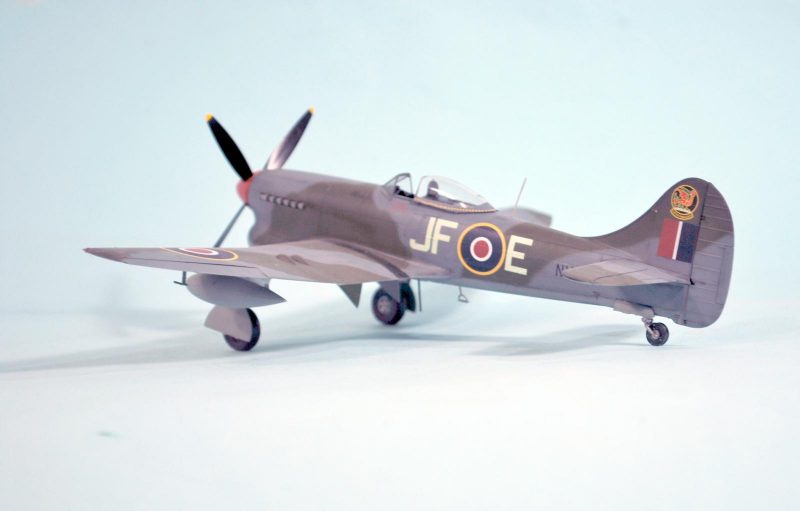
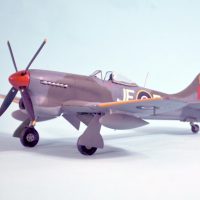
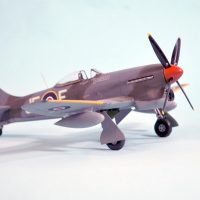
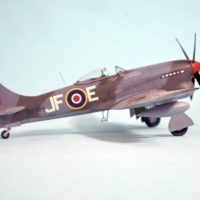

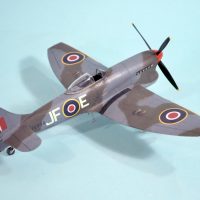
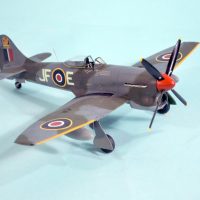
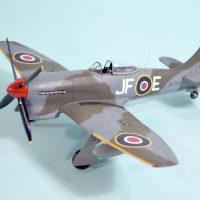
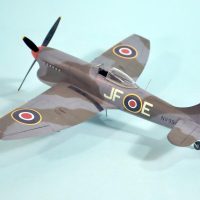
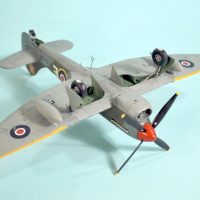
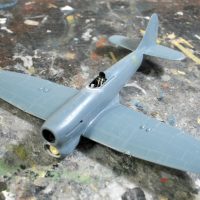
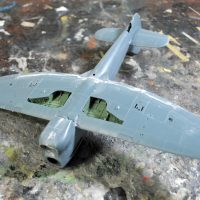
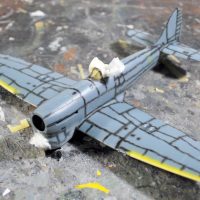
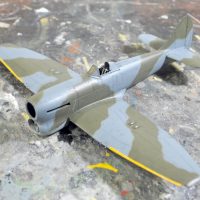
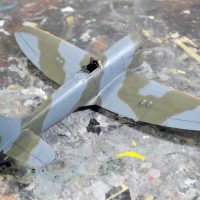
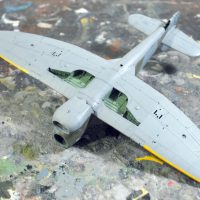
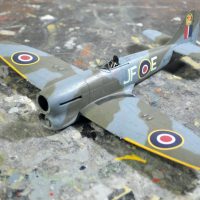
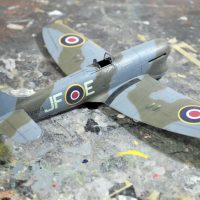
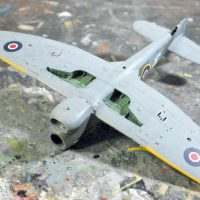
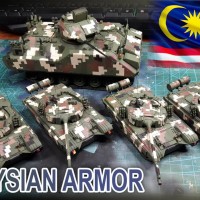
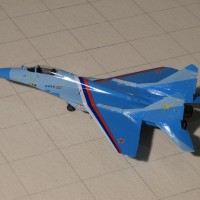


Excellent build, Tom!
Loved reading Clostermann's bio.
Really nice build, Tom @tcinla.
Thanks for sharing all the information regarding Pierre's biography and the build itself.
It was a pleasure to follow the thread.
very nice job!
one of my favorites plans, must build one one day - I'll use your images as an inspiration.
Thanks Tom for this beautiful rendition of the Tempest, as for the complete info, as usual. Bravo!
There are many discussions about the red color of the spinner, concerning the exact S/N. I made some researches, and I found contradictory info from Clostermann himself. Interesting ? Anyway, your version stands for "strongly possible", and I plan to do the same as well.
Le Grand Cirque is a must to read!
Thanks again Tom, Clostermann is a real symbol for us, Frenchies ?
Beautiful build Tom, one of my favorite planes from that era. Enjoyed reading Roland Beamont description of this airplane.
Nice work, Tom. I always come to your articles to look, read and learn and am never disappointed. Great version of this famous plane.
Thanks for those helpful construction tips TC. That sort of stuff really helps out others when they tackle a kit like this one @tcinla. I always enjoy the backstories of course, and this one is no different. Great stuff and a wonderful model too!
Hard to say what is more interesting the man, Clostermann or the model. Clostermann was definitely a complex man caught in complex times. The Falklands or the Malvinas war and Clostermann will be a enigma for some. I always think of the movie "Wag the Dog" given the subject matter. As all wars seem to bring out the best and the worst of people.
Another Cleaver classic,article and build.
Two thumbs up.
Very nice job, Tom. Thanks for the construction tips...I've got the original kit in the stash and all help is greatly appreciated...
Great looking Tempest. I read The Big Show when I was twelve so this paint scheme has always been my favorite.
Great job,Tom!
Another winner from Hawker’s SoCal assembly line! Very nice, Tom.
Thanks for the tips Tom. Great result in the end.
A good-looking Tempest Tom! Well done.
Very Nice, I need one of those in my collection - not only because the Tempest is a fierce machine, but I'm also born and live in Curitiba!